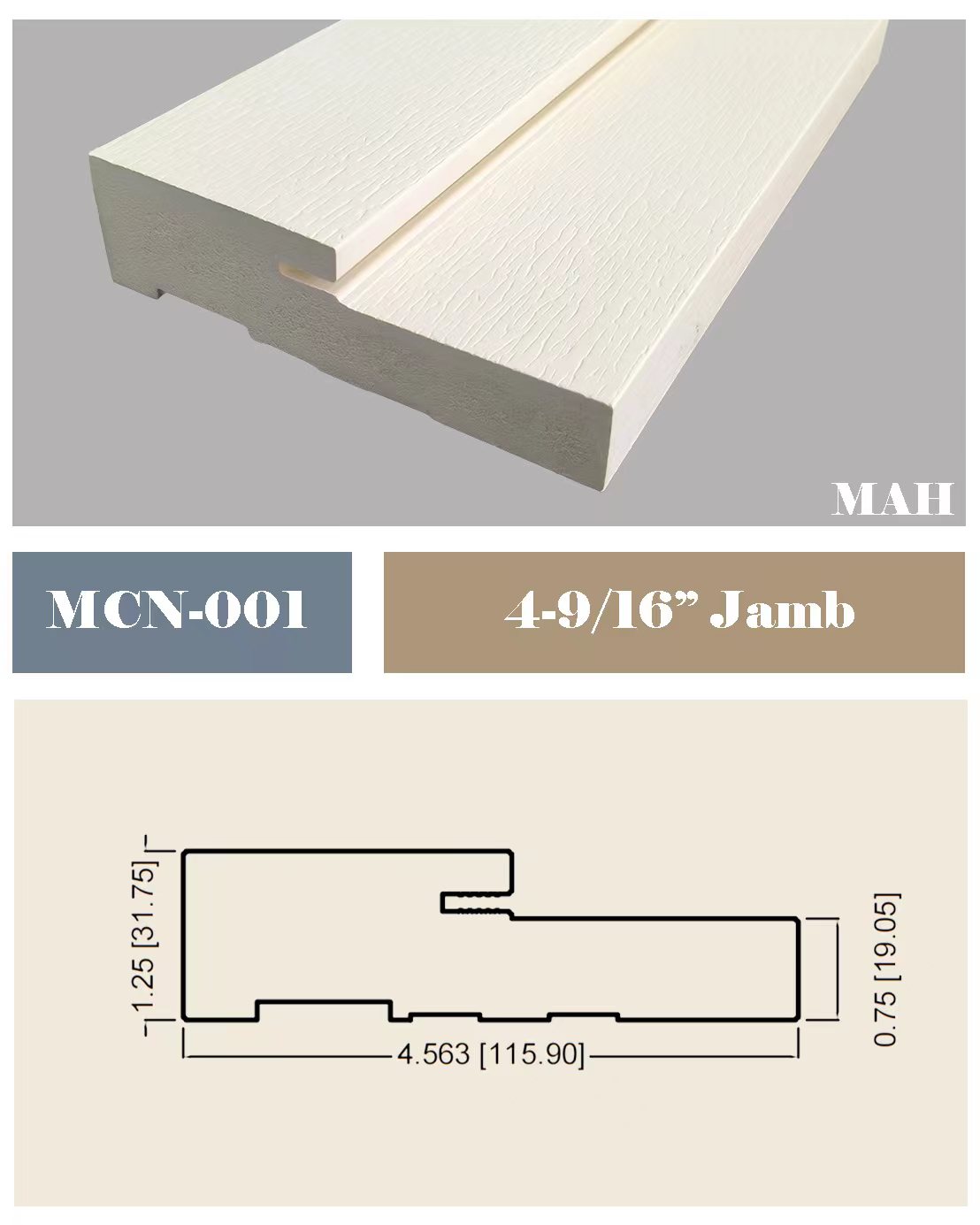Garage door jambs are essential components that ensure the stability and security of your garage door system. Choosing the right material for your garage door jamb can significantly affect the longevity, aesthetics, and maintenance of the door. This article delves deep into comparing Pvc Garage Door Jambs, wood, and metal, helping you make an informed choice.
Introduction to Garage Door Jamb Materials
● Overview of Garage Door Jambs
Garage door jambs play a crucial role in holding the door in place. As such, the choice of material for these components is not merely aesthetic but also functional. It’s essential to choose a material that aligns with your home’s needs, architectural style, and your maintenance capabilities.
● Importance of Selecting the Right Material
The right material can enhance the lifespan of your garage door, maintain aesthetic harmony with your home, and minimize maintenance hassles. With options like PVC, wood, and metal, homeowners are often faced with the challenge of selecting the best material for their specific requirements.
Understanding PVC Garage Door Jambs
● Composition and Properties of PVC
PVC, or polyvinyl chloride, is a versatile synthetic material known for its durability and resistance to environmental factors. It is a popular choice for garage door jambs due to its lightweight nature and the fact that it doesn't warp or rot like wood, nor does it rust like metal.
● Advantages of Using PVC for Garage Door Jambs
PVC garage door jambs are highly favored for their longevity and low maintenance needs. They are resistant to moisture, termites, and other pests, making them ideal for regions with extreme weather conditions. Additionally, they can be manufactured in various colors and finishes, providing versatility in design.
● PVC Garage Door Jamb Manufacturers and Suppliers
When considering PVC garage door jambs, it's crucial to choose a reliable Pvc Garage Door Jamb manufacturer such as those found in China. China Pvc Garage Door Jamb offerings often come with competitive pricing, especially if sourced through OEM Pvc Garage Door Jamb services or Wholesale Pvc Garage Door Jamb arrangements. Reliable Pvc Garage Door Jamb factory options ensure quality and fast delivery to meet your needs.
Benefits of Wooden Garage Door Jambs
● Natural Aesthetics and Appeal
Wooden garage door jambs are celebrated for their natural beauty and warmth. They add a classic touch to any home and can be easily customized to match the exact look desired by homeowners. The unique grains and textures of wood are appealing and can significantly elevate curb appeal.
● Durability and Repair Considerations
While wood can be durable if properly maintained, it does require regular upkeep to prevent issues such as rotting, warping, or pest infestations. However, one of the benefits of wood is that it can be easily repaired or replaced, often allowing for partial amendments rather than full-scale replacements.
Metal Garage Door Jambs: Pros and Cons
● Strength and Resilience of Metal
Metal, particularly steel, is renowned for its strength and ability to withstand significant weight and pressure. Metal garage door jambs are often preferred in industrial settings due to their ability to handle heavy use and provide high security.
● Potential Downsides, Including Rust
Despite their strength, metal jambs can suffer from rust and corrosion, especially in areas with high humidity or salt exposure. This can compromise their structural integrity over time. They also lack the design flexibility of wood and PVC, often presenting a more utilitarian appearance.
Comparing Cost and Longevity
● Initial Cost Analysis of PVC, Wood, and Metal
PVC garage door jambs tend to have a higher initial cost compared to wood but are comparable to high-quality metal jambs. However, when considering lifecycle costs, PVC often emerges as more economical due to lower maintenance needs.
● Long-term Durability and Maintenance Costs
In terms of longevity, PVC and metal surpass wood because they withstand environmental impacts without as much decay or need for constant maintenance. This aspect makes PVC and metal more cost-effective in the long run, especially when labor and materials for maintenance are accounted for.
Aesthetic Considerations for Home Design
● How Material Choice Affects Home Exterior Look
Choosing the correct material for your garage door jamb can have a significant impact on your home's exterior aesthetics. Wood offers a traditional charm, PVC offers a modern and clean look, and metal gives a sturdy and industrial feel.
● Customization Options with Each Material
PVC offers extensive customization options, including an array of colors and textures that can mimic wood. Wood, while traditional, can be stained or painted in various finishes. Metal finishes are typically more limited but can include galvanized or painted options to suit specific aesthetics.
Installation and Maintenance Efforts
● Ease of Installation for Each Material
PVC jambs are lightweight and straightforward to install, often requiring basic tools and minimal labor. Wood requires precision and skill for installation, while metal, although robust, can be cumbersome to handle due to weight and the need for specialized tools.
● Maintenance Demands and Best Practices
PVC requires virtually no maintenance aside from occasional cleaning. Wooden jambs need periodic sealing or painting to protect against the elements. Metal jambs should be inspected regularly for rust, and protective coatings may need occasional renewal.
Environmental Impact and Sustainability
● Ecological Benefits and Drawbacks of Each Material
PVC, while durable, poses environmental concerns due to its manufacturing process and end-of-life disposal. Wood is a renewable resource but contributes to deforestation unless sourced responsibly. Metal recycling is highly efficient, making it a more sustainable choice.
● Recycling and Disposal Considerations
When it comes to disposal, PVC can be challenging due to its chemical composition, whereas wood is biodegradable. Metal stands out as an environmentally friendly option due to its recyclability.
Climate Suitability and Weather Resistance
● How Each Material Reacts to Different Climates
PVC is highly resistant to moisture and is ideal for humid or rainy climates. Wood fares well in dry climates but can suffer in wet conditions without proper treatment. Metal performs well across various climates but may rust in coastal areas.
● Weatherproofing Capabilities of PVC, Wood, and Metal
PVC's inherent weatherproofing abilities make it a top choice where exposure to elements is a concern. Wood requires additional treatments for weatherproofing, and metal, while sturdy, benefits from galvanized coatings to prevent rust.
Final Recommendations and Decision-Making
● Summary of Key Points for Selection
Choosing the right material for your garage door jamb depends on various factors, including climate, aesthetic preference, maintenance capability, and budget. PVC garage door jambs offer a balance of aesthetics and practicality, wood provides classic charm, and metal ensures durability.
● Guiding Questions to Make the Best Material Choice
Consider questions such as: What is my budget? How much maintenance am I willing to perform? What is the climate like in my area? What aesthetic am I aiming for? Answering these can guide you toward the material that best fits your needs.
About MOONLIT
MOONLIT is a prominent name in the manufacturing industry, specializing in FRP doors and PVC profiles. Their facility spans 60,000 square meters and is equipped with state-of-the-art machinery, enabling a production capacity of 350,000 doors annually. With their expertise in both WPC/PVC door frames and FRP doors, MOONLIT ensures quality and fast delivery, making them a leader in the global market. Their products are renowned for their durability and aesthetic appeal, serving customers across North America, Europe, and Asia.


